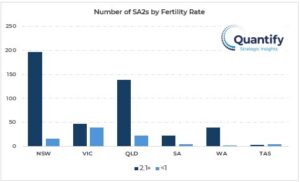Urban growth restrictions are the real reason housing is too scarce and too dear, writes Rob Burgess in the IPA Review
To see the article, click on the link below.
In Praise of Sprawl – IPA Review
Urban growth restrictions are the real reason housing is too scarce and too dear, writes Rob Burgess in the IPA Review
To see the article, click on the link below.
In Praise of Sprawl – IPA Review
Growing social stratification is becoming increasingly evident in the spatial distribution of fertility rates across Australia.
Fertility rates reflect a complex interplay between economic stability, government policy, urbanisation, employment trends, housing affordability, marriage patterns, dwelling preference, cost of living, and social norms.
While much is made of the nation’s declining national fertility rate, now at 1.63 (measured as children per female), identifying emerging regional trends is essential to understanding the changing social and economic context, and addressing the worsening housing crisis.
Notably, the number of SA2s with a fertility rate below ‘1’ across Australia continues to grow, primarily in the east coast capitals, especially Melbourne. Unsurprisingly, this pattern is largely concentrated in inner city areas reaffirming the long-known correlation between high-density living and low fertility rates. To the extent that this phenomenon reflects shifting cultural & social attitudes, it is noteworthy that in virtually all instances, these locations are within a State and/or Federal seat held by the Greens.
Against the national trend, there are a significant number of SA2s, most of which are located in NSW and QLD, where the fertility rate is above the replacement rate of 2.1 and is growing. These are dispersed throughout middle and outer suburbia, growth areas, and regional centres.

Persisting with generic assumptions about the type of housing to be provided based on a theoretical planning vision will fail to meet the housing needs of large segments of Australia’s rapidly growing population.
Understanding trends in fertility rates, and the factors underlying these, provides valuable insight into the demand for housing types and locational preference. It also enables more effective long-term strategic planning, infrastructure investment, and a more informed response to the social divide unfolding across the nation.
For a detailed understanding of the population and demographic factors impacting your project, contact Rob Burgess at rob.burgess@quantifysi.com.au or Angie Zigomanis at angie.zigomanis@quantifysi.com.au